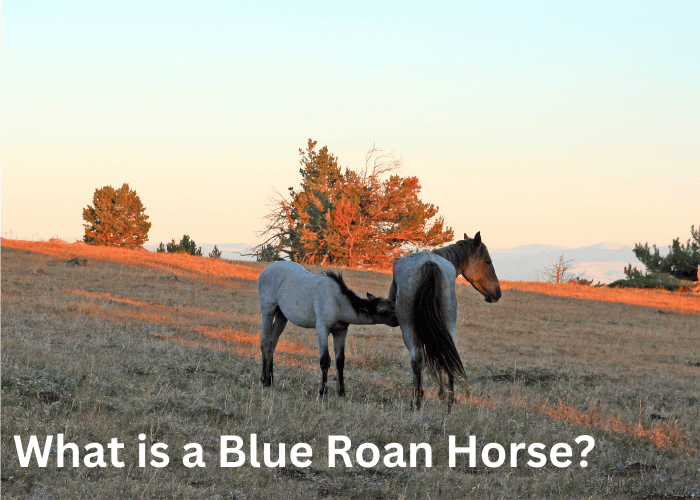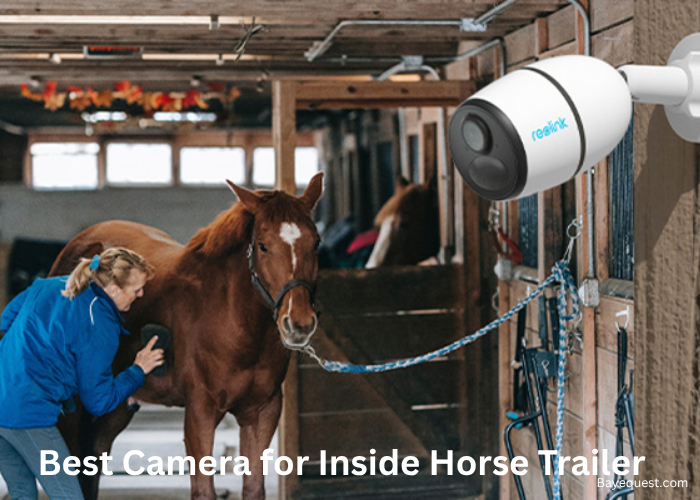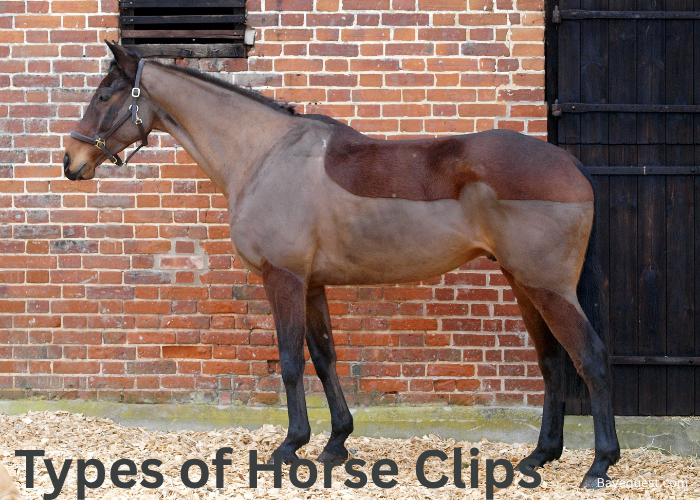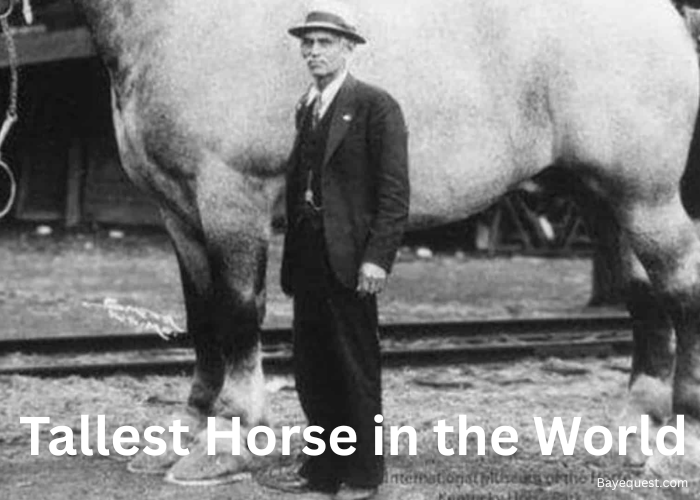Have you ever seen a horse shimmer under the sunlight, its coat a mesmerizing mix of midnight blue and silver? Meet the blue roan horse, a rare gem in the equine world.
These horses aren’t just a treat for the eyes; they carry a legacy as rich and vibrant as their coats. Whether you’re a seasoned equestrian or simply a horse lover, the allure of the blue roan is undeniable.
In this blog, we’ll explore the fascinating world of blue roan horses. So, saddle up, and let’s embark on this journey together.
What is a Blue Roan Horse? Key Takeaway
A blue roan horse has a black base coat interspersed with white hairs, creating a blue-gray appearance. Unlike other roans, the blue roan retains its black head, lower legs, mane, and tail, which contrast with its body. This distinct coloration results from the roan gene affecting the black coat color.
What is a Roan Horse?
A roan horse is a sight to behold. Picture this: a horse with a coat that’s like a sprinkling of snow over colored earth, where white hairs mix evenly with its base color, be it red, black, or bay.
This gives them a soft, frosted appearance that doesn’t change much as they age, unlike other horses whose colors might darken or lighten. Roan is unique because it’s not just a color; it’s a pattern, a natural blend that makes each roan horse distinct.
So, when you see one, you’re looking at a living mosaic, a masterpiece of nature’s own design.
What is a Blue Roan Horse?
A blue roan horse is a stunning creature with a coat that combines black and white hairs, giving it a striking bluish-gray appearance.
The “blue” in blue roan doesn’t mean the horse is actually blue. Rather, the mix of dark and light hairs creates a cool, slate-like effect that seems to shimmer under different lights.
Blue roans have a consistent color pattern throughout their lives, unlike some other horses that might change shades as they age. Blue roans are one of several types of roan horses, and they stand out for their distinctive and captivating coloration.
Related read: What are Colt Horses?
Characteristics of a Blue Roan Horse
The following characteristics come together to define the stunning and unique appearance of a blue roan horse.
They include:
Black base coat
A blue roan horse has a black base coat. This means that the main color you see on the body is black, but it’s interspersed with white hairs.
This unique mixture gives the blue roan its signature silvery-blue effect, making it a standout in any crowd.
Black points
The term “black points” refers to the areas of the horse’s body where the hair remains solidly black, without any white mixing.
These points include the horse’s ears, mane, tail, and lower legs. These striking contrasts add to the dramatic and appealing look of the blue roan.
Black mane and tail
Speaking of the mane and tail, these are usually pure black on a blue roan horse.
The dark, unbroken color of the mane and tail beautifully frames the horse’s body, enhancing the icy blue hue of the mixed coat.
Genetics
The genetics behind the blue roan color are fascinating. It’s all about a combination of genes that determine how black and white hairs distribute across the horse’s coat.
A specific gene called the Roan gene causes this scattering of white hairs. For a horse to be a blue roan, it must have one Roan gene and two copies of a black color gene, without any genes for bay or chestnut colors. This precise genetic mix is what creates the distinctive blue roan coat.
Breeds Commonly Found with Blue Roan Coloring
Quarter Horse: The American Quarter Horse often sports the blue roan coat. Known for their incredible sprinting abilities, these horses are a favorite in rodeo events. Their muscular build and calm demeanor make them excellent work and riding horses.
American Paint Horse. Featuring distinctive patterns and often blue roan coloring, American Paint Horses are popular for their colorful coats and friendly nature. They excel in various disciplines, from riding to show events. (Read also: Pinto Horse Vs Paint.)
Mustang. Wild and free, Mustangs can exhibit beautiful blue roan coats. These horses, descendants of once-domesticated stock, are rugged and hardy, symbolizing the spirit of the American West. (Now, find out the price of a Mustang Horse using our guide.)
Percheron. This draft breed from France can be found in blue roan. Percherons are known for their strength and were originally used for heavy hauling in farming and as war horses. (Read also: Percheron Horse Cost.)
Tennessee Walking Horse. Known for their smooth gaits like the unique running walk, Tennessee Walking Horses in blue roan have a striking appearance. They are popular for both show and leisure riding.
Missouri Foxtrotter. Recognized for the foxtrot gait, Missouri Foxtrotters with blue roan coloring are both beautiful and functional. They provide a comfortable ride, ideal for long trails.
Paso Fino. Originating from Spanish horses, Paso Finos are known for their natural, four-beat, smooth gait. Blue roan in this breed adds an exotic touch to their already elegant demeanor. (Related read: Paso Fino Horse Price.)
American Saddlebred. This breed is known for its showiness and can come in blue roan. American Saddlebreds are popular in the show ring for their style and spirit.
Breton. Originating from Brittany, France, Bretons are often used for draft and farm work. The blue roan in Bretons is rare but highly prized for its stunning look.
Brabant. Similar to the Belgian draft, Brabants are strong, heavy horses often used in pulling competitions. Blue roan gives them a particularly majestic appearance.
Welsh Pony. These small but sturdy ponies can be blue roan. Welsh Ponies are versatile, excelling in various disciplines from jumping to driving.
Appaloosa. Known for their spotted coats, Appaloosas can also be blue roan, which makes their spotting pattern even more striking. They are versatile and hardy, suitable for many equestrian activities.
How Much Do Blue Roan Horses Cost?
The cost of blue roan horses can vary quite a bit, depending on several factors. The horse’s age, training, breed, and pedigree all affect the price.
Generally, you might find blue roan horses starting around $1,500 for a basic riding horse. However, prices can soar up to $10,000 or more for a well-bred specimen with specialized training.
Because the blue roan color is relatively rare and highly sought after, these horses often fetch a higher price than their counterparts. If you’re looking to buy one, set a budget that considers the purchase price and ongoing care and maintenance costs.
Blue Roan Horse Names
Here are some name ideas for a blue roan horse, organized into categories for Classy, Pop Culture, and Simple names:
Classy Blue Roan horse names
- Midnight Majesty
- Sapphire Sky
- Blue Aristocrat
- Royal Azure
- Indigo Ice
- Blueblood Baron
- Celestial Sapphire
- Mystic Moonlight
- Silvery Scepter
- Arctic Aristocracy
Pop Culture Blue Roan horse names
- Blue Avatar (from Avatar)
- Stark (inspired by Game of Thrones, House Stark)
- Mystique (from X-Men)
- Pandora (from Avatar)
- Kenobi (from Star Wars)
- Nightcrawler (from X-Men)
- Sonic (from Sonic the Hedgehog)
- Korra (from The Legend of Korra)
- Merlin (from King Arthur mythology)
- Vader (from Star Wars)
Simple Blue Roan horse names
- Blue
- Sky
- Storm
- Ash
- Smokey
- River
- Stone
- Frost
- Dusty
- Blizzard
Roans Vs Grays
Roans and grays are two distinct coat colors in horses, each with its own unique characteristics.
Roans have a stable coat pattern where white hairs are evenly interspersed through their base color. from birth throughout their life, they have a consistent speckled appearance.
This pattern does not change as they age, maintaining a stable look. In contrast, gray horses are born with a darker coat that lightens as they grow older.
This lightening occurs because their hairs turn white, leading to many older grays appearing almost completely white. The key difference lies in the aging process.
Roans consistently retain their mixed hair coloration, while grays transform over time, moving from their birth color towards white. This makes it easier to distinguish between the two, especially as the horses age.
Dun Vs Roan
Dun and roan are two distinct coat colors in horses, each with unique traits.
Duns are characterized by their tan or gold body color, alongside darker points like the mane, tail, and lower legs. A key feature of duns is the dorsal stripe, which runs down the middle of their back. This stripe is a telltale sign of the dun coloring.
Conversely, Roans have a mix of white and colored hairs spread evenly across their bodies. This blend stays consistent throughout their lives, giving them a frosted look that doesn’t change much as they age. Unlike duns, roans don’t have the dorsal stripe, and their coat color can be based on any shade, not just tan or gold.
Understanding these differences helps in identifying whether a horse is dun or roan.
Related read: Dun vs Buckskin.
Rabicano Vs Roan
Rabicano and roan are two different coat patterns in horses that are often confused due to their similar appearances.
Rabicano is characterized by a specific pattern of white hairs that are concentrated around the flank, tail, and sometimes the ribs. The white hairs in a Rabicano are not evenly dispersed throughout the coat like in a roan.
Rabicanos often have a roaning that appears more as stripes or flecking rather than a uniform mix.
On the other hand, roan horses have a much more uniform mix of white and colored hairs across their entire bodies. This mix remains consistent over most of the horse’s body, except for the face, lower legs, mane, and tail.
Unlike Rabicanos, the roan pattern is stable throughout the horse’s life.
Sabino Vs Roan
Sabino and roan are two coat patterns in horses that may seem similar but are genetically and visually distinct.
Sabino has white spotting that often includes white legs, belly spots, and boldface markings, such as blazes and snips. The amount of white can vary, ranging from minimal white markings to nearly all-white bodies.
The pattern can create lacy or roan-like edges, but the white extends from specific areas rather than being evenly mixed throughout the coat.
Roan, on the other hand, features an even distribution of white hairs mingled with the horse’s base color across most of the body. This gives roans their consistent frosted appearance. The roan pattern does not typically affect the horse’s face, mane, tail, and lower legs, which usually retain the solid base color.
The key distinction lies in the pattern’s distribution and the presence of patchy versus even blending.
Varnish Roan Vs Roan
Varnish roan and roan are two distinct coat patterns in horses, each with unique characteristics.
Varnish roan is associated with the Appaloosa breed. It develops over time, gradually increasing the white areas while preserving some of the original coat color. This pattern can mimic a classic roan but is part of the leopard complex typical of Appaloosas.
Roan, on the other hand, shows a consistent mix of white and colored hairs across the horse’s body from birth. This mix remains stable throughout the horse’s life. The face, lower legs, mane, and tail usually keep their base color, free from white mixing.
In short, varnish roan changes with age and is specific to Appaloosas, while true roan is stable over time and seen in many horse breeds.
Different Shades of Roans
The following are the different shades of roans available:
Blue roan
A blue roan horse has a base coat of black mixed evenly with white hairs. This combination gives the horse a striking blue-gray appearance.
The mane, tail, and lower legs remain solid black, providing a sharp contrast to the frosted body color. Blue roans are admired for their beautiful, unique coloring that stands out in any setting.
Red roan horse color
Red roan horses have a chestnut or sorrel base color that is interspersed with white hairs. This mix creates a reddish appearance, which is where the name comes from.
The mane and tail of a red roan may have a mixture of red and white hairs, contributing to the overall dusty pink or copper look. Red roans are particularly vibrant and eye-catching.
Bay/Strawberry roan
Bay roan horses combine the typical bay coloring, rich red or brown with black points on the mane, tail, and lower legs, with a significant amount of white hairs spread throughout their coat.
This blend softens the bay base into a more muted but still warm shade. The classic bay markings help distinguish bay roans from other types, maintaining the dark points while the body shows a frosted effect.
Read more: Strawberry Roan Horse.
When is a Roan not a Roan?
The term “roan” refers to horses with a uniform mixture of white and colored hairs across their bodies. However, there are instances when a horse might look like a roan but isn’t genetically a true roan.
Here are a few scenarios when a “roan” is not a true roan:
Grey horses that are roaning. Grey horses are born with a dark coat that lightens as they age due to increasing white hairs. Young greys can appear roan because they still have a mix of dark and light hairs, but as they mature, they usually turn completely white.
Rabicano pattern. This is often mistaken for roaning because it features white ticking primarily around the flanks, ribs, and sometimes the tail. Unlike true roans, the white hairs in rabicano horses are not evenly distributed across the entire body.
Varnish roan Appaloosas. These horses may develop a pattern that looks similar to roaning as they age. The varnish roan pattern increases in white areas while preserving some of the original color around the bony areas like hips, shoulders, and face. It’s part of the leopard complex genetics, not the roan gene.
Sabino pattern. Some sabino horses can have extensive white markings that might mimic roaning. The sabino gene can cause a roan-like appearance with scattered white hairs.
Ticking. Some horses may have scattered white hairs due to other genetic factors or environmental conditions.
Roan Gene Linked to Red Factor?
The roan pattern in horses is caused by a specific gene called the Roan gene. This gene affects the distribution of white hairs mixed with the horse’s base color.
It’s independent of the base color, which means it can appear in conjunction with any color. The base color itself, whether black, bay, or chestnut, is determined by other genetic factors, including the red factor.
The red factor refers to a gene that determines whether a horse will have a chestnut base color (presence of two recessive alleles) or not (presence of at least one dominant black allele).
The roan gene interacts with this base color. So, if a horse has the chestnut base color and inherits the roan gene, the horse will be a red roan. This means it will display a mix of white and red (chestnut) hairs.
Thus, while the roan gene is not linked to the red factor in a genetic sense (they are separate genes), the appearance of a roan horse in terms of color will depend on the underlying base color, which the red factor can influence.
This results in variations like red, blue, and bay roans, depending on the base color genes the horse carries along with the roan gene.
Misconceptions About The Blue Roan Horse
There are a few common misconceptions about blue roan horses that often lead to confusion.
First, many people think blue roan horses will change color as they age, similar to grey horses. However, unlike greys, blue roans maintain their unique mix of black and white hairs throughout their lives.
Another misconception is that all blue roan horses are born from two roan parents. In reality, the roan pattern can appear even if only one parent carries the roan gene. This is because the roan gene is dominant, meaning that it only takes one copy for the roan appearance to manifest.
Finally, there’s the idea that blue roan is a specific breed. In fact, blue roan is a coat color, not a breed. It can occur in many horse breeds, including Quarter Horses, Paints, and some draft breeds.
Care and Management of Blue Roan Horses
Caring for blue roan horses isn’t much different from looking after other horses. However, there are a few specifics to keep in mind to keep them looking and feeling their best.
First, regular grooming is key. This not only keeps their distinctive coat shiny and healthy but also helps prevent skin issues that could be hidden under their dense hair. Use a soft brush to gently remove dirt and distribute natural oils throughout their coat.
Next, pay close attention to their diet and exercise. Like all horses, blue roans need a balanced diet rich in nutrients, and adequate exercise to maintain their health and prevent issues like obesity or joint problems.
Finally, keep up with regular veterinary check-ups. This includes vaccinations, deworming, and dental care, which are crucial for preventing diseases and ensuring your blue roan horse lives a long, happy life.
With proper care and management, blue roan horses can be a wonderful addition to your stable.
The Significance of Blue Roan Horses in History and Culture
Blue roan horses hold a special place in history and culture, capturing the imagination and admiration of many.
Historically, their striking appearance made them desirable in the cavalry as a symbol of nobility. Their unique color often symbolized strength and beauty, making them popular choices for parades and ceremonial roles.
In various cultures, blue roan horses are seen as good luck charms. Their rare coat color is sometimes believed to bring fortune and protection to their owners. This mystique adds to their allure and the stories that surround them.
Today, blue roan horses continue to be celebrated in art, literature, and media. They are often portrayed as noble steeds in movies and books, symbolizing both the wild and untamed and the loyal and steadfast.
This cultural significance keeps them in the public eye and heart, cherished not just for their utility but also for their beauty and the rich lore accompanying them.
FAQs
Are blue roan horses rare?
Yes, blue roan horses are considered rare. Their unique coat color is not as commonly found as other colors like chestnut or bay.
What makes a horse a blue roan?
A horse is called a blue roan when it has a coat mixed evenly with white and black hairs, giving it a blue-gray appearance. The mane, tail, and lower legs usually stay black, contrasting with the lighter body.
Is a blue roan horse more expensive than horses of other colors?
Yes, blue roans are more expensive than horses of other color. Due to their rarity and striking appearance, blue roan horses can be more expensive than horses of more common colors. Prices can vary depending on factors like breed, age, and training.
Can the coat color of a blue roan horse change over time?
No, the coat color of a blue roan horse does not change over time. Unlike gray horses, which become lighter as they age, blue roans maintain their distinctive coat color throughout their lives
Can two non-roan horses produce a blue-roan foal?
It’s unlikely but possible if both non-roan horses carry the recessive roan gene without expressing it themselves. If each parent passes this hidden gene to their foal, the foal can be a blue roan. However, typically at least one parent must visibly display the roan coat pattern.
Conclusion
As we wrap up our journey into the enchanting world of blue roan horses, remember that these magnificent creatures are more than just a pretty coat. Each blue roan carries a legacy of rarity, beauty, and mystique.
Whether you’re an avid equestrian or you appreciate the splendor of nature, the blue roan horse stands as a testament to the extraordinary. So, next time you spot one, take a moment to appreciate its unique blend of colors—a true masterpiece on hooves.
Keep the magic of the blue roan in your heart, and let its rarity remind you of the wonders that roam our world.








